|
|
Check out: 
Cuba Symposium Tackled Tough IssuesBy Dawn Gable April 8, 2011
The more than 50 panels covered a wide range of topics such as literature, biotechnology, race and gender, the colonial period, José Martí, social theory, religion, the diaspora, and tourism. To browse through or read the more than 200 papers presented at the Cuba Futures event, check the Bildner Center website from time to time where they will all be published eventually. The following is just a peek at some of the event highlights which addressed US-Cuba relations, the Cuban economy, humanitarian assistance, and digital media and included intimate discussions with legends of Cuban literature and Latin Jazz. US-CUBA RELATIONS Opening night plenary featured Robert Pastor, U.S. national security advisor on Latin America and the Caribbean during the Carter administration, who led the first secret negotiations with the Cuban government after diplomatic ties were severed in the early 60's. Pastor had just returned from accompanying President Carter on his second trip to the island where they met with both of the Castro brothers. Recalling what the elder brother told him decades ago, “US policy is to wait for me to die and I do not intend to cooperate,” Pastor implied that Fidel’s health is at least stable saying that “Fidel does not seem any more likely to cooperate now than he did then.”
He also denounced the fact that the current administration continues the “democracy programs” that led to the arrest of Alan Gross, who he admitted was in violation of Cuban law regardless of any details and who he hopes “doesn’t have to serve as long as the Cuban Five have here in US prisons, which has been 13 years.” Regarding the eminent economic reforms, Pastor opined that Raul “wants to hand to the next generation an economy that works.” But he said it was not clear if changes in the Cuban system will impact US-Cuba relations because of the symbolism of the embargo to Cuban-Americans, 55% of whom think the sanctions should remain even while 77% of them admit the embargo doesn’t work. When asked by Mauricio Font, the chief organizer of the symposium, whether or not Cuban Americans are really driving US policy, he responded affirmatively reminding the audience of the tiny number of Florida votes that delivered Bush II to power in 2000. However, he conceded two other major factors: Cuba is low priority, so politicians don’t want to waste political capital on the issue and the “physical existence of the original sinners” Fidel and Raul. To close, Palmer recited a quote by George Washington that could apply to both Cuba and the US: The nation which indulges toward another a habitual hatred … is in some degree a slave. It is a slave to its animosity … which is sufficient to lead it astray from its duty and its interest. ECONOMY
Pavel Vidal assured that Cuba is gradually emerging from the recent crisis despite limited convertibility of the Cuban peso (CUC), noting, for example, that by mid-2010 Cuba had paid 2/3 of its frozen bank accounts. He painted a modestly optimistic future looking forward to institutional reforms, the expansion of contracted Cuban medical services to Algeria and Angola, and the realization of megaprojects such as the construction of a modern port at Mariel and oil refineries in Cienfuegos and Matanzas.
Camila Piñeiro provided a look at the non-state sector that is expected to spike over the coming half decade from around 500 thousand individuals participating in non-state economic activities in 2010 to 1.8 million non-state enterprises in 2015. New opportunities include leasing taxis, barber chairs, restaurants, night clubs, etc.; forming agricultural cooperatives; and licensing individuals to hire a small workforce. When asked if the new market reforms are contradictory to the principles of the revolution, Vidal cautioned not to “confuse the market with capitalism.” Piñeiro explained that the new and unique model will reinforce the socialist notion that personal interests are indivisible from those of the community by decentralizing the collection and use of taxes and incentivizing social forms of production such as cooperatives. In another panel on the economy, Emily Morris, formerly of the Economist Intelligence Unit, mentioned her talks with economists and decision-makers on the island and related that most Cubans don’t understand how profound the reforms are going to be and that the next couple of years are going to be very risky and bumpy. Vidal agreed explaining that the economic reforms will create winners and losers so the system will have to be able to support the losers. It will be the Party’s task to instill faith in the people that the changes are in the best interests of everyone in the long run. HUMANITARIAN ASSISTANCE Everleny Pérez expressed his concern for micro-financing again when he asked a panel of US based NGO’s when they might be updating their assistance approach to include offering micro-credits. After Caritas Cubanas, Fundacion Amistad, and Acceso shared with the audience the numerous important humanitarian aid shipments, projects and delegations to Cuba they have sponsored over the years, they assured that they are pursuing such programs, but are stalled waiting for the new US regulations to be published first and then the Cuban government will have to accept. Ben Rodriguez, representing the Cuban Artist Fund talked about the difficulties NGO’s face due to constantly shifting US policy, the apprehension of philanthropists to get involved with Cuba projects because of the “murky regulations,” and the obstacles to partnering with third country or international entities because of the Helms-Burton Act. DIGITAL MEDIA Ted Henken moderated the Digital Dilemma’s panel and brought to the audience’s attention several pertinent developments: the Venezuelan fiber optics cable is set to go live this summer; Cuban opposition blogs are no longer blocked from being accessed inside Cuba; the “leaked” MINIT video in which a cyber security official gives a lecture on the cyber war being waged by the US against Cuba; the new TV mini-series “Cuba’s reasons”, a recent episode of which took aim at a few Cuban bloggers, and the video response “Citizen’s reasons” by Yoani Sanchez and others
Investigative blogger Tracy Eaton of Along the Malecón introduced his other blogging venture, the Cuba Money Project, where he follows the money involved in carrying out US policy toward Cuba, which he totals at around $98 million in the past 4 years. To put that number into perspective, according to Eaton, the US only provided $600,000 in hurricane aid to Cuba in 2008, a year of devastating storms, while the State Department has earmarked $30 million for internet for internet freedom projects this year in Cuba and other countries. As an example of the types of projects that receive these funds, Eaton exposed the initiative of Stephanie Rudat, author of “Effective Tools and Strategy: Kicking it Up a Notch in Cuba and Beyond,” whose company receives State Department funding and is organizing a meeting in Panama this month called {think}CUBA which “will convene select leaders in activism for human rights and democratic freedoms outside of Cuba to become educated ambassadors of movements working toward democratizing and empowering Cubans.” Vision Comun, a youth community media project in the Eastern town of El Cobre, was presented by Diana Coryat of the University of Massachusetts. In 2007, she donated a camera and some basic equipment to a group of young people and taught a 3 day workshop on documentary making. When she returned a year later, she found that they had “gone wild” and made several videos. Now they offer regular community screenings of their work and hold an annual 3 day film festival. Another community and participatory media screened clips of their work in a special session. TV Serrana began in 1993 in Cuba’s Sierra Maestra mountains in the far eastern province of Granma as a cooperative effort of UNESCO, the Cuban government, the National Association of Small Farmers (ANAP), and the Cuban Institute of Radio and Television (ICRT). Over the years the children of farmers who were trained by TVS have produced hundreds of documentaries many of which are broadcast on national television; some of these productions have received awards in national and international film festivals. TVS filmmaker Carlos Rodriguez is currently touring the US with 21 films. For more information check out TV Serrana’s website. LEGENDS OF CUBAN LITERATURE & LATIN JAZZ Special events included a conversation with Leonardo Padura, one of Cuba’s leading writers who in addition to his famous crime and historic novels, is known for his written reviews of literature and music, investigative journalism, and screenplays. In a lively exchange with the audience, Padura explained the different techniques of character development when dealing with fictional, as opposed to historical characters. He mused over how many people ask him for updates on the lives of his fictional characters as if they were real people.
To bring the symposium full circle Arturo and others returned on closing night to discuss the Havana-New Orleans historical connection and the role of music in cultural diplomacy. During Ned Sublette’s animated and humorous tracing of various rhythms through history, he emphasized that Havana was the first great music center in the hemisphere and that Cuba mounted the second radio tower on the entire continent. Panelists agreed that among their students and understudies, those of Cuban heritage are much more knowledgeable about the history and development of music, which they concurred, is essential for a true jazz performer. Arturo clarified that there are not Cuban musicians and Cuban American musicians as “we all share the same roots.” © 2011 Havana Times.org Reflections on the US NGO's in Cuba: Challenges, Realities and Promise panel discussion, as part of the Bildner Center's Cuba ConferenceBy Fundación Amistad Board Member, Lana Mullen Cuba Futures: Past and Present is an international and interdisciplinary symposium hosted yearly by the Bildner Center at CUNY. The 2011 symposium featured a fascinating array of presenters, from veteran thinkers on Cuban policy to young scholars offering fresh perspectives on issues that have proven intractable over the past 50 years. The presentations ranged from informative status updates to such innovative thinking as re-purposing the US-owned Guantanamo base to produce sugar-based ethanol. Timely reports were given on subjects in the news today such as the Sixth Congress and the recently initiated oil drilling in the Florida Straits. In between sessions, participants demonstrated a palpable sense of collegiality and delight to see one another despite differing points of view. Our own Luly Duke organized a special session titled “US NGOs in Cuba: Reality, Challenges, and Promise.” The informative presentations on the work and goals of NGOs elicited a lively discussion amongst the session attendees eager to share past experiences and offer support to future efforts. No matter what the perspective and personal experience, it was clear that all participants shared a deep and abiding fondness and concern for our close neighbor, and a unified hope that our nations would someday be reunited in friendship. 
Going beyond politics to help Cubans nowBY MIRTA OJITO May 30, 2010 There are people you talk to who are so inspiring, so full of life, so driven and so enthusiastic, that you feel the urge to drop everything and run to join them. Talking to Carmen Vallejo was just like that. Only I couldn't run to her. She lives in Cuba and I'm in New York, but we are separated, it turns out, only by water and distance. Carmen and her husband Rey Febles, give love, joy and support to about 200 children and youngsters with cancer. With the help of foreign friends, Carmen and Rey throw birthday parties, celebrate Halloween, Christmas, and produce theater and musical shows for the entertainment of children some of whom are so sick that they have forgotten how to smile.. But soon enough they remember. Talk to Carmen for a while, or visit her website at desdecuba.com/carmenyrey and you will too. I found myself laughing with her when she told me a story of one of their youngsters, mutilated by cancer, who one day said, "Today I woke up with my right foot," a translation of a Spanish saying that means everything is going right. "Of course," the girl went on, "I always do. My left leg is gone." I heard about Carmen and Rey through Luly Duke, whose New York-based foundation Amistad is one of the friends the Cuban couple depends on. Duke, who is Cuban American and whose maiden name is Alcebo Fundora left Cuba in 1960, when she was 14. In 1975 she married Anthony Drexel Duke, of the famed Duke family that made its original fortune on tobacco. Duke University is named for the family. Needless to say, Luly Duke could live a life of luxury in the Hamptons, where she has a home, and belongs to groups such as the Garden Club of East Hamptons. But Duke has long had a humanitarian and activist streak. Many years ago, she joined her husband's work in The Harbor for Boys and Girls, Inc, a multiservice organization for inner-city children, which he founded. In 1995, after 35 years in exile, Duke returned to Cuba and her life changed. "I realized the people of Cuba needed help and I was in a position to help," she says simply. And for some reason, Duke makes the very complicated, very political, very exhausting topic of Cuba sound new, simple and refreshing. Help is needed. We can give it. Why not do it? Why not, indeed? The needs of the Cuban people are overwhelming: everything from toilet paper to food, coloring pencils, aspirin and underwear. Duke has focused her funding on educational, cultural and medical needs -- three areas, where, by the way, the Cuban government boasts of excelling. But Duke doesn't discuss politics. To do what she does, she has managed to earn the trust and good will of both the U.S. and the Cuban governments and focus on her foundation's mission: to build bridges to Cuba. She has a license from the Treasury Department and maintains good relations with U.S. and Cuban officials. In addition to donating more than 3,000 pounds of over-the-counter medicines and medical supplies for Carmen and Rey's kids, Fundación Amistad has, among other things, sent about 1,000 pounds of sports equipment, and, with partners, more than $90,000 in medical supplies and technical books to three medical centers in Havana. There are people you talk to who are so inspiring, so full of life, so driven and so enthusiastic, that you feel the urge to drop everything and run to join them. Talking to Carmen Vallejo was just like that. Only I couldn't run to her. She lives in Cuba and I'm in New York, but we are separated, it turns out, only by water and distance. Duke said she would like to see Carmen and Rey's work serve even more kids in other areas of Cuba, but the foundation, like others in these times of economic uncertainty, is hurting for funds. To keep afloat, they need to raise $45,000 before the end of the year. Carmen, who is deeply religious, said she and her husband started the program after Mother Teresa visited Cuba in 1988 and asked her to take care of children with cancer. Carmen was serving as her translator during the visit. She said her group is "tolerated" by the Cuban authorities, who don't like the fact that she takes the children wherever they are invited, be it the home of a foreign western ambassador or a meeting with Eusebio Leal, Havana's historian. "What we do is beyond politics, religion and race," Carmen said. "We just want to ease the very real pain of these kids and see them smile." Duke has the same approach. She has already established the bridge. Others can walk with her or build their own. © 2010 The Miami Herald Caribbean Houses: History, Style, and Architecture
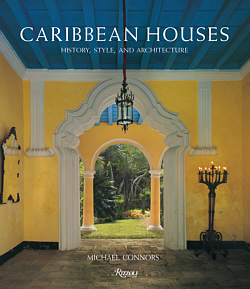 Fundación Amistad is happy to highlight Dr. Connors' latest book. A truly wonderful look at the historic architecture and decorative arts of the island residences is presented with glorious color photos and informative text in CARIBBEAN HOUSES by Michael Connors. I have a few of his other books, and knew what to expect from this former antiques dealer turned author. It does not disappoint. 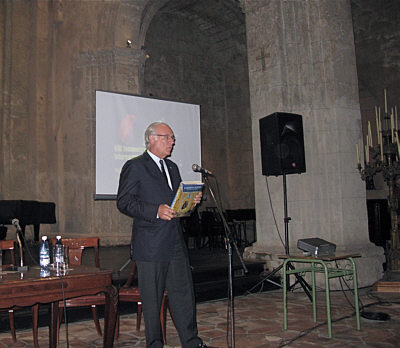 Presentacion del libro "Caribbean Houses", por autor Michael Connors en la Basilica Menor del Convento de San Franisco de Asis Havana, Cuba Noviembre 30, 2009 Cuban Elegance
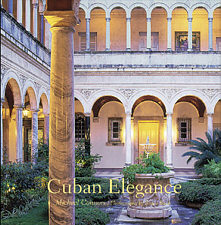 Fundación Amistad board member Dr. Michael Connors is the author of this beautiful book. “Cuban Elegance is an astonishing work. That Michael Connors and Bruce Buck were able to navigate the bureaucracies to get to Cuba and to the subjects of the book; astonishing that with an admitted paucity of research material they were able to craft a book that reveals the wealth of historic artifacts in Cuba. Connors’ concise, comprehensive and well-researched narrative along with Bruce Buck's beautiful images bring to light the stylistic and historical influences of three centuries of Cuba's heritage. Kudos to both gentleman for what must have been an arduous task. The fruits of their labors is a book that should be an elegant addition to a great many libraries.” Caribbean Houses: History, Style, and Architecture
 Fundación Amistad is happy to highlight Dr. Connors' latest book. A truly wonderful look at the historic architecture and decorative arts of the island residences is presented with glorious color photos and informative text in CARIBBEAN HOUSES by Michael Connors. I have a few of his other books, and knew what to expect from this former antiques dealer turned author. It does not disappoint.  Presentacion del libro "Caribbean Houses", por autor Michael Connors en la Basilica Menor del Convento de San Franisco de Asis Havana, Cuba Noviembre 30, 2009 Tropicana Nights: The Life and Times of the Legendary Cuban Nightclub
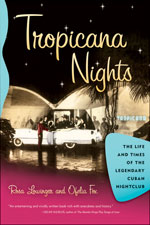 This wonderful book was co-written by Rosa Lowinger, another of Fundación Amistad’s board members. “Journalist Rosa Lowinger and Ofelia Fox, widow of Tropicana’s last owner, vividly portray the cultural richness and roiling social problems of pre-Revolutionary Cuba and take the reader on an intimate insider's tour of one of the world's most glamorous venues at its most brilliant moment.” |
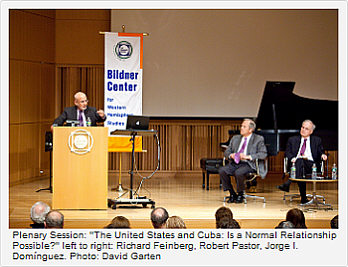 HAVANA TIMES, April 8 — Last week hundreds of scholars gathered at the City University of New York’s Graduate Center to share their Cuba related research and projects; to discuss the island’s current affairs, history and future; and to enjoy each other’s anecdotes about their travels to the country where most US citizens are still forbidden to go.
HAVANA TIMES, April 8 — Last week hundreds of scholars gathered at the City University of New York’s Graduate Center to share their Cuba related research and projects; to discuss the island’s current affairs, history and future; and to enjoy each other’s anecdotes about their travels to the country where most US citizens are still forbidden to go.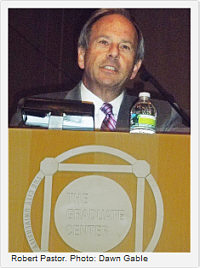 Pastor shared that President Carter would be submitting a written report about his visit to both President Obama and Secretary of State Clinton. While he listed several positive steps made by the Obama administration to improve relations between the countries, he was clear they were insufficient, specifically mentioning Obama’s refusal to take a position on bills that would have lifted the travel ban outright and facilitated agricultural sales to Cuba.
Pastor shared that President Carter would be submitting a written report about his visit to both President Obama and Secretary of State Clinton. While he listed several positive steps made by the Obama administration to improve relations between the countries, he was clear they were insufficient, specifically mentioning Obama’s refusal to take a position on bills that would have lifted the travel ban outright and facilitated agricultural sales to Cuba.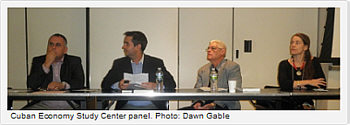 Thanks to modest adjustments in regulations made by the Obama administration, several Cuban scholars were able to travel to the US and participate in the symposium unlike in past editions. On the panel “Cuban Perspectives on the Cuban Economy”, four economists from the University of Havana think-tank Centro de Estudios de la Economía Cubana (Cuban Economy Study Center, CEEM) discussed various aspects of the Cuban economy.
Thanks to modest adjustments in regulations made by the Obama administration, several Cuban scholars were able to travel to the US and participate in the symposium unlike in past editions. On the panel “Cuban Perspectives on the Cuban Economy”, four economists from the University of Havana think-tank Centro de Estudios de la Economía Cubana (Cuban Economy Study Center, CEEM) discussed various aspects of the Cuban economy.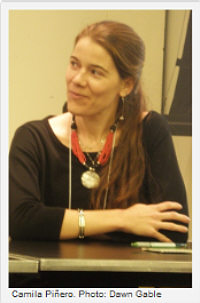 Everleny Pérez discussed the process of updating the Cuban economic model framed by the new economic guidelines released to the public late last year. In particular, he pointed out the lack of emphasis on micro-credits as well as contradictions in the document that will need to be addressed in the upcoming 6th Party Congress (April 16-19). Armando Nova described the guidelines as laying out “what” needs to be done, but now the “how” has to be worked out.
Everleny Pérez discussed the process of updating the Cuban economic model framed by the new economic guidelines released to the public late last year. In particular, he pointed out the lack of emphasis on micro-credits as well as contradictions in the document that will need to be addressed in the upcoming 6th Party Congress (April 16-19). Armando Nova described the guidelines as laying out “what” needs to be done, but now the “how” has to be worked out.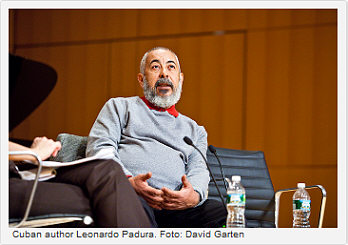 Havana Times editor Circles Robinson opened the panel discussion on Cuba’s blogosphere by telling the story of how the site, which has some 20 contributors, came into being and discussing a bit about the composition, workings, and evolution of the collective and the project. He said presenting a cross section of opinions and offering some proposals for change is a strong feature of the online publication. He assured that after some initial hassles the many diary writers of Havana Times continue to write unabated. Robinson said that some Cuban readers have expressed fear of visiting the site from work computers. Luckily the publication offers a Spanish language email version that works around this issue.
Havana Times editor Circles Robinson opened the panel discussion on Cuba’s blogosphere by telling the story of how the site, which has some 20 contributors, came into being and discussing a bit about the composition, workings, and evolution of the collective and the project. He said presenting a cross section of opinions and offering some proposals for change is a strong feature of the online publication. He assured that after some initial hassles the many diary writers of Havana Times continue to write unabated. Robinson said that some Cuban readers have expressed fear of visiting the site from work computers. Luckily the publication offers a Spanish language email version that works around this issue.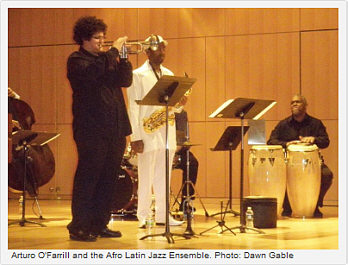 Latin jazz enthusiasts were treated to an on opening night performance by the Arturo O’Farrill Afro Latin Latin Jazz Ensemble, which included two of his sons Adam and Zack; two Cuban born and trained musicians, Yosvany and Yunior Terry; and Roland Guerrero, an internationally renowned Latin Jazz artist who played with, among numerous others, the Cuban musical legend Chico O’Farrill, the father of Arturo.
Latin jazz enthusiasts were treated to an on opening night performance by the Arturo O’Farrill Afro Latin Latin Jazz Ensemble, which included two of his sons Adam and Zack; two Cuban born and trained musicians, Yosvany and Yunior Terry; and Roland Guerrero, an internationally renowned Latin Jazz artist who played with, among numerous others, the Cuban musical legend Chico O’Farrill, the father of Arturo.